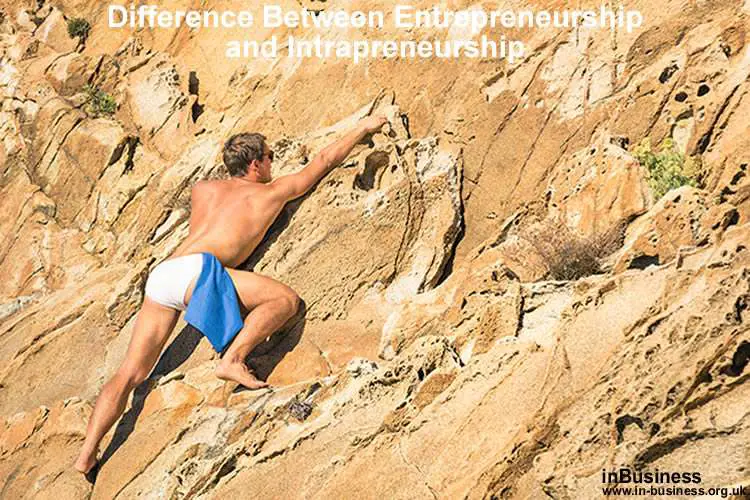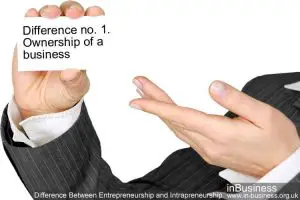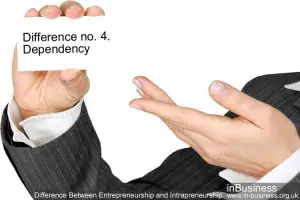Difference Between Entrepreneurship and Intrapreneurship

This article is about the difference between entrepreneurship and intrapreneurship. It has been written by Russell Bowyer. Towards the end of the article is an info-graphic showing the seven differences between entrepreneurship and intrapreneurship.
In this article, I will be looking at the following subjects:
- Entrepreneurship
- Intrapreneurship
- Difference no. 1. Ownership of a business
- Difference no. 2. Financial loss
- Difference no. 3. Financial gain
- Difference no. 4. Dependency
- Difference no. 5. Fund raising and capital
- Difference no. 6. Resources
- Difference no. 7. The ultimate say
- Infographic on differences between entrepreneurship and intrapreneurship
- Examples of successful entrepreneurship
- Examples of successful intrapreneurship
I shall begin by explaining what an entrepreneur is versus what an intrapreneur is, before running through the differences.
Entrepreneurship

In the Oxford Dictionary, Entrepreneurship is defined as ‘The activity of setting up a business or businesses, taking on financial risks in the hope of profit.’
Traditionally entrepreneurship has been defined as the process of designing, launching and running a new business. Entrepreneurs start businesses, offering either products or services, or both. They are innovative and creative and happy to break the norm.
An entrepreneur is a person who is typically more comfortable with taking risk. They have given up the ‘Security’ of a job to startup a company to employ staff. They have to be comfortable as a leader and as a manager of people.
The level of risk that an entrepreneur takes is very much dependent on the individual. But where an entrepreneur is comfortable with taking higher levels of risk, a small business can become a much larger organisation.
An entrepreneur is the person who brings the product or service into reality. Sometimes being the inventor, whilst other times starting a new business to provide an existing product or service, but in a better way.
Intrapreneurship

At the point of writing this article Intrapreneurship is not defined in the Oxford Dictionary, but it has made its way onto Wikipedia. Wikipedia’s definition of Intrapreneurship is ‘The act of behaving like an entrepreneur while working within a large organisation.
Effectively, an intrapreneur is nothing but an entrepreneur within the boundaries of an organisation.
Intrapreneurship is where an individual integrates risk-taking within his corporate management approach.
Intrapreneur however is a term found in the Oxford Dictionary, and is defined as ‘A manager within a company who promotes innovative product development and marketing.’
Gifford Pinchot III’s first book in 1985 was called ‘Intrapreneuring: Why You Don’t Have to Leave the Corporation to Become an Entrepreneur’
The American Heritage Dictionary acknowledged the term to mean: ‘A person within a large corporation who takes direct responsibility for turning an idea into a profitable finished product through assertive risk-taking and innovation.’
Intrapreneurs tend to take new initiatives without being first asked to do so. They tend to focus on innovation and on creativity, much like an entrepreneur.
So what is the difference between entrepreneurship and intrapreneurship?
Difference no. 1. Ownership of a business

The first and most obvious difference between entrepreneurship and intrapreneurship is ownership. An entrepreneur is an individual that ‘starts-up’ a business and is the owner.
Whereas, an intrapreneur is an employee of the company and does not usually have any ownership. However, some employees, likely the intrapreneurs among them, may hold shares in the company they work for in the form of shares.
Ownership of a company gives the entrepreneur the ultimate control over what the business does. The Entrepreneur is the furthermost risk-taker of the business.
The intrapreneur may take ‘risks’ within the corporation where he works. However, the final risk comes down to the responsibility of the business owner. There is no actual financial risk taken by the intrapreneur.
The main difference between entrepreneurship and intrapreneurship is in the level of risk taken by the individual.
Difference no. 2. Financial loss

The second difference between entrepreneurs and intrapreneurs is with regards to the ultimate sacrifice. The ultimate sacrifice being made by an entrepreneur as one of potential financial loss.
Many times the entrepreneur will use his own money for his startup business. They will many times also use their own assets (like their own home) to secure loans to finance their small business start-up.
An intrapreneur will not usually be in a position to raise funds for the organisation. The intrapreneur is therefore not risking any of their own money in any organisation where they are involved.
Entrepreneurs have been known to lose everything. This sometimes includes their home after their business has collapsed. Whereas, if a company fails, the intrapreneur can just walk away, so bear no risk at all.
Financial loss for the entrepreneur comes in two forms. Firstly, if the business makes a loss, and runs out of cash, the entrepreneur is the one who has to make up the difference. Secondly, where a company collapses and goes into liquidation, the entrepreneur could lose everything. This will depend on what monies are owned by the company, and what’s personally secured by the entrepreneur.
Difference no. 3. Financial gain

On the converse of financial loss, the third difference between entrepreneurship and intrapreneurship is that the entrepreneur is the one who will reap the rewards of success.
This financial reward is two-fold. Firstly, where the company makes a profit, the entrepreneur will be able to reward himself with profits in the way of dividends.
Secondly, the final benefit to the entrepreneur is on the sale of the business. Where the organisation has done exceptionally well, the entrepreneur could be in for a significant gain from the sale proceeds.
It’s possible that due to the nature of an intrapreneur, they may have arranged a ‘profit share’ for themselves. This will mean they receive a reward for their efforts. However, this will always only be a share of profits. Which compared to the entrepreneur, who is entitled to 100% of the balance of the profits.
Also, the intrapreneur will not gain from the sale of the business in the same way. This is except where they have an agreement in place with the business owner to take a share of the proceeds at the point of sale.
Without entrepreneurs there would be no intrapreneurs…intrapreneurs are dependent on entrepreneurs in the first place to start the business
Difference no. 4. Dependency

The fourth difference between an entrepreneur and an intrapreneur is about dependency…intrapreneurs are dependent on entrepreneurs…although arguably some of the most successful companies this case is slightly reversed.
All intrapreneurs are dependent on entrepreneurs in the first place to start the business. Without entrepreneurs there would be no intrapreneurs to flourish. The initial spark or original genius is provided by the entrepreneur. Whereas the intrapreneur is responsible for keeping the fire going and for adding fuel to it.
Good ‘entrepreneur-leadership’ will lead to having intrapreneurs within their businesses. Great entrepreneurs will encourage intrapreneurship. However, there’s always the worry that the intrapreneur will leave to set up in competition.
There’s the risk of losing a key employee who acts as an intrapreneur, making it extremely difficult to replace that individual. So it is the entrepreneurs duty therefore to not only encourage intrapreneurship, but also to support and look after their intrapreneurs within the business. Thereby avoiding these top-employees leaving to go else where.
Having said that, there are many ’employees’ who are and will always be happy to be just that…employees. Having the extra burden of risk is not something that everyone wishes to have.
Being an entrepreneur carries with it a certain level of risk, whereas intrapreneurs can simply walk away when a business goes wrong. Which is not every ones ‘cup of tea’.
Difference no. 5. Fund raising and capital

The fifth difference between entrepreneurs and intrapreneurs is in relation to fund raising and capital.
A small business’s survival can sometimes depend upon the entrepreneurs ability and willingness to raise funds.
There will be the initial startup capital for the entrepreneur to find, which in many cases will be from their own resources. Or even if it is from other financial sources, like banks and other lenders for example, the loan will more than likely need personal security and personal guarantees.
Intrapreneurs never have to carry this level of risk. They are fully reliant on the entrepreneur to carry the burden of risk of things going wrong.
Also, most businesses go though a certain amount of ups and downs in their life-time. In the downs, which usually involves cash flow problems, it is the entrepreneur, and not the intrapreneur that will have to come up with the funds.
Even where a separate division or company is setup for the intrapreneur to run, any capital needed by the intrapreneur, is provide for him by the company (or by the entrepreneur).
Difference no. 6. Resources

The sixth difference between entrepreneurship and intrapreneurship is about business resources, and who is responsible for providing them.
Effectively the resources used by an entrepreneur are provided by him. Entrepreneurs have to be extremely resourceful.
Whilst intrapreneurs are resourceful, they are not required to provide the resources need by the company. The resources needed by the intrapreneur are already provided to him by the company.
The resources we are referring to here are not just ‘cash’ and capital, as discussed in difference 5 above, but it’s all the other resources needed to run a business.
Different companies and difference business types required specific resources, but at no time is an intrapreneur expected to put their hands in their pockets for the business.
However, having said that, the are many intrapreneurs which do and are likely to provide some resources…or certainly offer to do so.
We are also not necessarily talking just about physical resources either. There are personal resources required to succeed in business also. These include educational resources, emotional resources and human resources.
Difference no. 7. The ultimate say

The final difference in this article between entrepreneurship and intrapreneurship is who has the ultimate say in the business.
The butt stops with the entrepreneur. An entrepreneur always also has the final say in what happens within a business.
So although intrapreneurs do tend to have a high level of autonomy and creativity, they are under the ultimate control and guidance of the entrepreneur who owns the business.
Many entrepreneurs live and die by their sword, many of whom will put their last dime to keep a business afloat.
There’s no decision that an entrepreneur can’t take within an organisation that requires approval. The exceptions to this rule are where a business is jointly owned and run, or whereby lenders are involved and have a certain amount of say over certain business decisions within the business.
Whereas intrapreneurs are given certain boundaries to work with. Intrapreneurs by their very nature are extremely autonomous, and encouraged to be so. However, there will always be certain larger decisions whereby the intrapreneur will need to seek approval.
Below is an Infographic showing the differences between entrepreneurship and intrapreneurship…

Having explained the differences between entrepreneurship and intrapreneurship, it is time for some examples of each, as follows:
Examples of successful entrepreneurship
This article would not be complete without some good examples of both entrepreneurship and intrapreneurship…
There are many successful entrepreneurs around the world. Some more successful and well known that others. The one that stands out for me and is most note worthy is Sir Richard Branson. Branson founded the Virgin Group, which controls more than 400 companies world wide.

Sir Richard Branson – The Virgin Group
Branson became an entrepreneur at an early age, starting his first venture at the age of just sixteen. His first business was a magazine called Student. His first business led to a mail-order record business. The rest is history, as they say. His net worth at the time of writing this article is over $5 billion.
Steve Jobs – Apple Computers
The second entrepreneur that I think about is Steve Jobs. It is difficult to put the two words ‘Successful’ and ‘Entrepreneur’ together without putting his name in the list. Like many successful entrepreneurs, Steve Jobs dropped out of college and then went on to setup one of the most successful companies in the world Apple with Steve Wozniak.
Bill Gates – Microsoft Corporation
Bill gates is one of the most famous entrepreneurs of all time. At certain points the richest man in the world and worth in excess of $79 billion. He co-founded the worlds largest PC software company Microsoft, which revolutionised computers with the Windows system.

Tej Lalvani – Entrepreneur and Dragons Den Multi-Millionaire
Tej Lalvani, a successful entrepreneur, is the CEO of the UK’s largest by sales vitamin company Vitabiotics, and will be working along-side Dragons Den Touker Suleyman too.
With a yearly turnover of more than £300 million, Vitabiotics stands strong as the largest company in the manufacturing of vitamins in UK.
Under the leadership of Tej Lalvani, the company has grown into one of the most innovative companies in the field of nutrition. The company now has reach of over 100 countries around the world.

Dragons Den Entrepreneur Sarah Willingham
With a net worth of nearly $19 million, Sarah Willingham, is a British entrepreneur, who also happens to be part of the Dragon’s Den.
She started out as a restaurant manager and went on to become one of the leading entrepreneurs in the food and drink industry. Dragons Den Sarah Willingham has no less than three leading brands under her management – The Bombay Bicycle club, The Real Greek and the Tootsies.
Listed as one of the most influential business persons by many magazines. She was also listed as part of the most successful women entrepreneurs below the age of 35, by The Sunday Times.

Dragons Den Entrepreneur Touker Suleyman
A fashion mogul, who has also been part of the Dragon’s Den investors’ panel since 2015, Touker Suleyman is the man behind the famous Hawes & Curtis brand of shirts.
With nearly half a century’s worth of experience in the fashion industry, entrepreneur Touker Suleyman has managed to craft his own style and success in fashion, as can be seen from Touker Suleyman’s net worth today.
He started his career quite early as an accountant. Suleyman quit this job to join the retail business, which helped to build Touker Suleyman’s net worth.
At the age of 18, he had made his mark with Kingsland Models, his own manufacturing company. As part of the business, he was making clothes for leading brands like Topshop, Dorothy Perkins and Marks & Spencer.
Examples of successful intrapreneurship
Whilst it would seem that the term intrapreneurship is relatively new, this is in fact the opposite, with the first example of successful intrapreneurship is at Lockhead Martin in 1943.
Skunk Works Project
Skunk Works created some of the most innovative aircraft models, including the P-80 fighter Jet. Lockhead Martin allowed Kelly Johnson (Skunk Works Founder) to work as an autonomous organisation with a small team around him.

Texas Instruments
In this case it was Larry Hornbeck who was the intrapreneur. Hornbeck changed the then video projector from what weighed as much as a small child and costing in excess of $15,000, to reduce it in size and cost. The Texas Instraments digital projector became the industry standard.
A more recent innovation by intrapreneur Paul Buchheit who created Gmail. Gmail revolutionised email at the time when Google introduced 1GB storage. This allowed users to keep their emails rather than having to delete them to keep within their smaller storage limit.
Intrapreneur Indra Nooyi at Pepsico

Indra Krishnamurthy Nooyi is an American business executive and is the current Chairperson and Chief Executive Officer of PepsiCo. Intrapreneur Indra Nooyi was originally born in India. She moved to America in 1978 at which time she was admitted to Yale School of Management.
She talks about how she flunked part of the exams there in relation to communication skills. With communication being one the the ‘Five C’s‘ of her leadership skills, this was a valuable lesson to her.
Nooyi is just one of 12 female CEOs in the Fortune 500. She has consistently ranked within the 100 most powerful women around the world. This list includes Angela Merkel and Hillary Clinton, both are ranked highly on the list.
Other intrapreneurship companies…
Other companies where there are inspiring examples of successful intrapreneurship include the likes of Shutterstock, Facebook, 3M, Sun Microsystems and a few others.
Also, if you’d like to discuss these differences between entrepreneurs and intrapreneurs on our business forum you can do this here – Business Forum Discussions. Also theres a forum post on “Difference b/w entrepreneurship and intrapreneurship“, I’d love your input there too.
If you would like to see this article in PowerPoint (ppt) style, see below:
[slideshare id=76177537&doc=differencebetweenentrepreneurshipandintrapreneurship-170521145045]
Finally please social share and comment below…
If you enjoyed reading this article about the difference between entrepreneurship and intrapreneurship, please share. Choose your favourite social media channel below. I’d also appreciate your comments below too, and thank you for reading in-Business Blog.
Thank you so much, you have helped in answering some questions.
Great blogpost Russel!